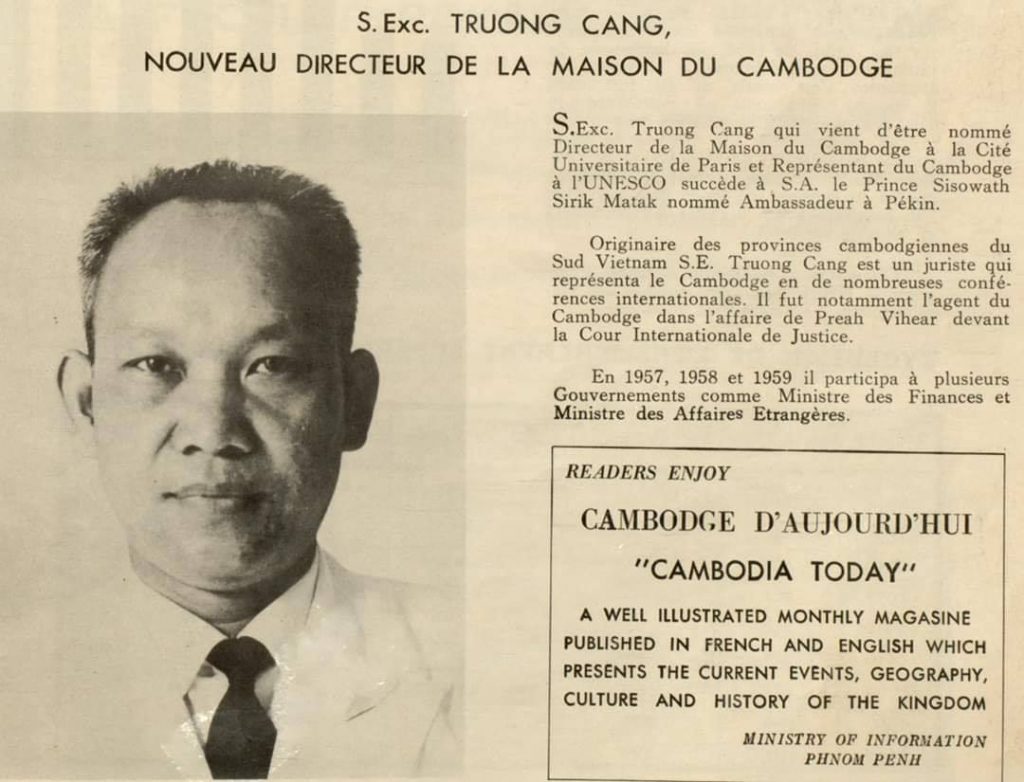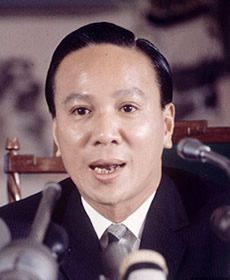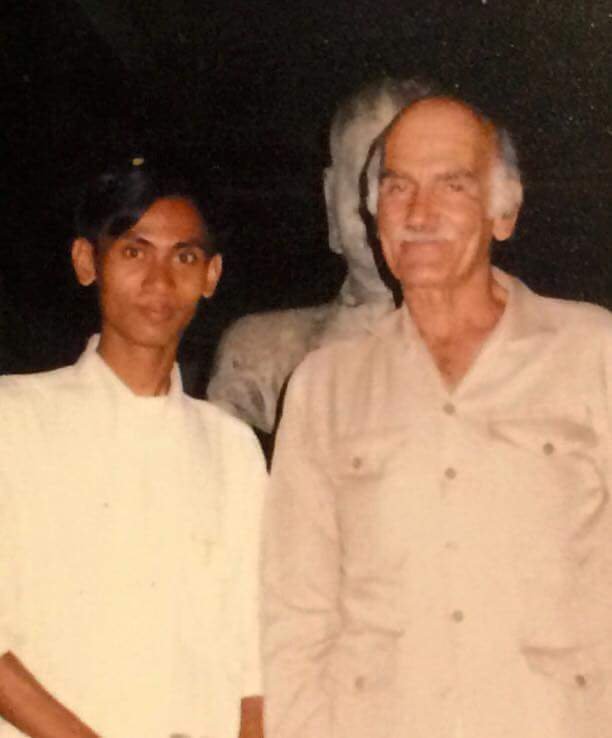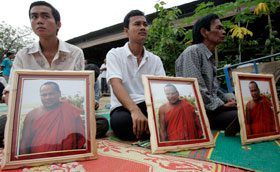On June 25, 1952, the US Legation (opened in Phnom Penh on November 14, 1950 and initially operating from the Hotel Le Royal) was raised to Embassy status at which point Donald R. Heath became the first U.S. Ambassador to Cambodia.
On June 25-27, 1970, government forces in Ratanakiri were evacuated after FANK asked the US and South Vietnam for assistance for two isolated garrisons at Ba Kev and Labang Siek in the province. The FANK units at Labang Siek would then move 35 km (22 mi) east along Route 19 to Ba Kev and would then be flown or trucked to Đức Cơ across the border to South Vietnam. The operation began on 25 June and was successfully completed by 27 June with 7,571 FANK troops, their dependents and refuges evacuated. ARVN losses were 2 killed while PAVN losses were 6 killed and 2 weapons captured.
On June 25, 1972, FANK forces headed to Neak Luong along Route 1. Two battalions of the elite 48th Khmer Krom Brigade were ambushed. The surrounded troops called for airstrikes., but none came. Short of ammunition, they radioed for artillery fire to rain onto their own positions. Out of 600 troops, only 13 returned to friendly lines.
On June 25, 1977, The Nation magazine published an essay by famed linguist and ‘anarchist’ scholar Noam Chomsky and Edward S. Herman titled “Distortions at Fourth Hand”, written on June 6. The pair criticized US policy and decried ‘fake news’ coming from Cambodia regarding stories of genocide. READ HERE
On June 26, 1958, Ambassador Strom reported that he had told Cambodian Foreign Minister Troung Cang on the afternoon of June 26 that he had no instructions on the Cambodian request for U.S. assistance in the latest dispute with South Vietnam. Strom told Troung that it was doubtful there was an ARVN incursion (into Cambodia), but in any case, South Vietnam had ordered its forces to withdraw. The same day the Embassy in Saigon reported that the MAAG Chiefs in Saigon and Phnom Penh had concluded that the Vietnamese incursion was probably a minor foray in pursuit of Viet Minh former prisoners. Ambassador Durbrow (in Saigon) concluded that his best role was to press for calm in Saigon and urge that Vietnam and Cambodia resume efforts to reach settlement of their outstanding differences.

On 27 June 1970, South Vietnamese President Nguyễn Văn Thiệu gave a televised speech in which he outlined South Vietnam’s Cambodia policy:
(1) South Vietnamese forces would continue to operate on Cambodian territory after the withdrawal of U.S. forces to prevent the PAVN/VC from returning to their base areas.
(2) South Vietnamese forces would continue to evacuate Vietnamese who wished to be repatriated.
(3) The South Vietnamese government would support the Cambodian government in meeting PAVN/VC aggression.
(4) future activities in Cambodia would be conducted without U.S. support.
(5) the bulk of South Vietnamese forces would be withdrawn from Cambodia
(6) the object of South Vietnamese actions was to improve South Vietnamese security and ensure the success of Vietnamization. The South Vietnamese military established a liaison office in Phnom Penh and monthly meetings of the JGS, FANK command and MACV were instituted.

On June 27, 1973, President Richard Nixon vetoed the Senate’s bid to end the bombing of Cambodia. His veto, however, had only a short-term impact: Within days, the whole Congress voted to cut off all funds for the Vietnam War as the ‘Case-Church amendment’ was passed by a margin of 325–86 in the House, 73–16 in the Senate, and Nixon signed it on July 1, 1973. The legislation prohibited further U.S. military activity in Vietnam, Laos and Cambodia unless the president secured Congressional approval in advance.

On June 27, 1981, The office of Head of State, known as the President of the People’s Revolutionary Council was renamed the Chairman of the Council of State. Heng Samrin, who had been the former since January 7, 1979, held the renamed position until April 6, 1992. On the same day Pen Sovan took up the role as the first Prime Minister of the People’s Republic of Kampuchea.
On June 27, 2005, Joseph A. Mussomeli was appointed Ambassador Extraordinary and Plenipotentiary for Cambodia. He would take up the position on September 22, 2005.
On June 27, 2011, the ECCC (Khmer Rouge Tribunal) second trial involving Nuon Chea, Ieng Sary, Ieng Thirith and Khieu Samphan- the regime’s four most senior surviving leaders officially opened with an initial hearing.
On June 27, 2012, His Imperial Highness Crown Prince Naruhito of Japan began a three-day visit to Cambodia. The next afternoon the now current emperor visited Angkor Wat along with his delegation and a local guide.

On June 27, 2012, the ‘Boeung Kak 13’- women imprisoned for protesting the filling in of Phnom Penh’s Boeung Kak lake, were released by the Court of Appeal. A panel of three judges upheld the two charges against the women, declaring they were still guilty of occupying state land and obstructing public officials in aggravating circumstances, but reduced their sentences from two and a half years to one month and three days – the length of time they had already served in Prey Sar prison.
On June 28, 1951, the leader of the communist Khmer Issarak movement formed the Khmer People’s Revolutionary Party, with Son Ngoc Minh, known as Achar Mein, the secretary of the Central Committee Party, Sieu Heng, known as Achar Sok, was the member of the Party Central Committee for Military Affairs.

On June 28, 1962, Philip D. Sprouse was appointed US Ambassador Extraordinary and Plenipotentiary for Cambodia.
On June 29, 1950, The United States established its first direct diplomatic relationship with Cambodia with the appointment of Donald R. Heath as Envoy Extraordinary and Minister Plenipotentiary. Heath presented his credentials to King Sihanouk on July 11, 1950.
On 29 June 1951, the Cambodia Customs Administration was first established in 1951 by the Royal Decree No. 661.
On June 29, 2017, Cambodia historian and scholar Dr. Michael Vickery passed away at the age of 86 in Battambang.

On June 29, 1973, President Nixon relayed assurances to Congress that United States military activity in Cambodia would end by August 15 and that he would seek Congressional approval if American military action was needed after that date.
A senior Administration official said that Congressional acceptance of six more weeks of bombing would allow the United States to continue the “extremely delicate” negotiations going on to end the fighting in Cambodia.
Earlier, Paul J. Hare, a Stat Department spokesman, insisted that “diplomatic irons were in the fire,” but he refused to provide details.
On June 30, 1970, U.S. troops completed their withdrawal from Cambodia. U.S. military aircraft continued to bomb positions in the country.
On June 30, 1978, the International Federation of Human Rights issued a report accusing the Cambodian regime of mass executions, forced labor, torture and intentional famine.
On June 30, 1993, the Cambodian national flag was readopted. The design had been used from 1948-70 and from 1975-76.

On June 30, 2007, Venerable Tim Sakhorn- an Abbot of North Phnom Denh temple in Phnom Denh Village, Takeo province, was arrested, defrocked and deported by the Cambodian government to Vietnam, where he was imprisoned the same day. He was accused of “undermining the friendship between Cambodia and Vietnam.” He was imprisoned in Vietnam until June 28, 2008. He was re-ordained in the US and granted political asylum in Sweden in July 2009.

On July 1, 1997, the military court asked the National Assembly to lift First Prime Minister Ranariddh’s parliamentary immunity so it could charge him with illegal weapons smuggling.
On 1 July 1990, Khmer Rouge forces stopped a passenger train in the countryside south of Phnom Penh. They fired directly into the carriages, and one witness, Svay Pech, “saw eight people killed in her carriage alone,” reporting that “the shooting went on a long time.” The Khmer Rouge shot the two soldiers guarding the train, and then separated the state employees from the rest. Svay Pech saw 5 more people shot dead, including several railway company workers. Those still alive were forced to carry the booty into the hills for the Khmer Rouge. Some too weak to march were left
for dead along the -way. According to Phnom Penh, at least 24 passengers and other civilians were murdered, and 52 wounded; Svay Pech suggests the toll was higher. Ten were still missing two weeks later.
On July 1, 2015, Cambodia sent a diplomatic protest letter to Vietnam over what it considered an encroachment of its border territory. The Ministry of Foreign Affairs and International Cooperation’s letter to its counterpart in Hanoi demanded that Vietnam cease all planned road construction and infrastructure projects along the border until the two nations had completely demarcated the border.
The ministry specifically requested that Vietnam stop construction work on three roads in Svay Rieng province, adjacent to the borderlines at border pillars which have not yet been demarcated. It also demanded that the Vietnamese provide the locations and maps of where it plans to build roads and other infrastructure projects in the area.
